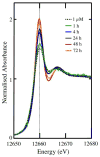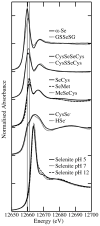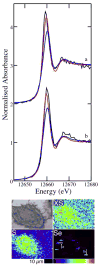Metabolism of selenite in human lung cancer cells: X-ray absorption and fluorescence studies
- PMID: 21957893
- PMCID: PMC3237720
- DOI: 10.1021/ja206203c
Metabolism of selenite in human lung cancer cells: X-ray absorption and fluorescence studies
Abstract
Selenite is an inorganic form of selenium that has a cytotoxic effect against several human cancer cell lines: one or more selenite metabolites are considered to be responsible for its toxicity. X-ray absorption spectroscopy was used to monitor Se speciation in A549 human lung cancer cells incubated with selenite over 72 h. As anticipated, selenodiglutathione and elemental Se both comprised a large proportion of Se in the cells between 4 and 72 h after treatment, which is in accordance with the reductive metabolism of selenite in the presence of glutathione and glutathione reductase/NADPH system. Selenocystine was also present in the cells but was only detected as a significant component between 24 and 48 h concomitant with a decrease in the proportion of selenocysteine and the viability of the cells. The change in speciation from the selenol, selenocysteine, to the diselenide, selenocystine, is indicative of a change in the redox status of the cells to a more oxidizing environment, likely brought about by metabolites of selenite. X-ray fluorescence microscopy of single cells treated with selenite for 24 h revealed a punctate distribution of Se in the cytoplasm. The accumulation of Se was associated with a greater than 2-fold increase in Cu, which was colocalized with Se. Selenium K-edge extended X-ray absorption fine structure (EXAFS) spectroscopy revealed Se-Se and Se-S bonding, but not Se-Cu bonding, despite the spatial association of Se and Cu. Microprobe X-ray absorption near-edge structure spectroscopy (μ-XANES) showed that the highly localized Se species was mostly elemental Se.
Figures







References
Publication types
MeSH terms
Substances
Grants and funding
LinkOut - more resources
Full Text Sources
Medical
Research Materials

